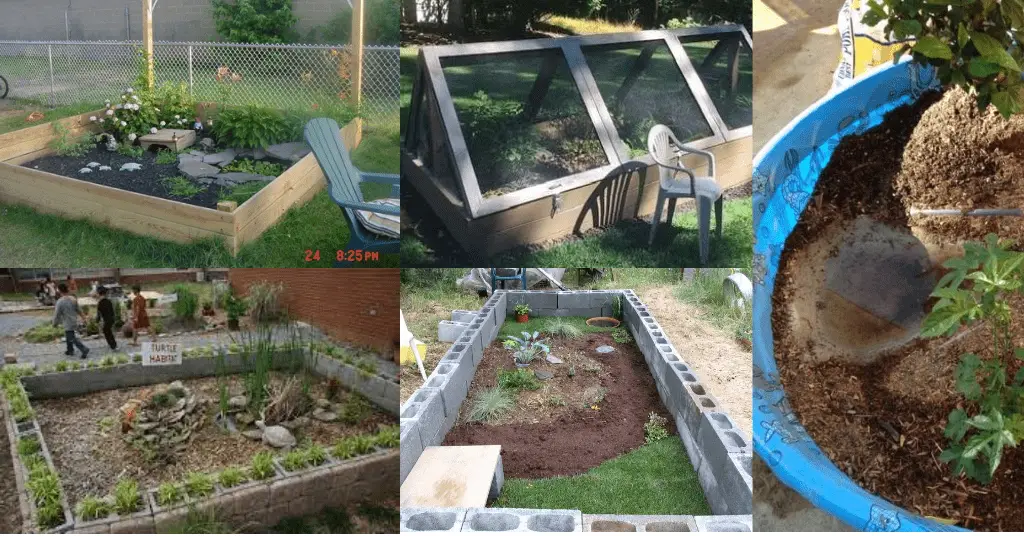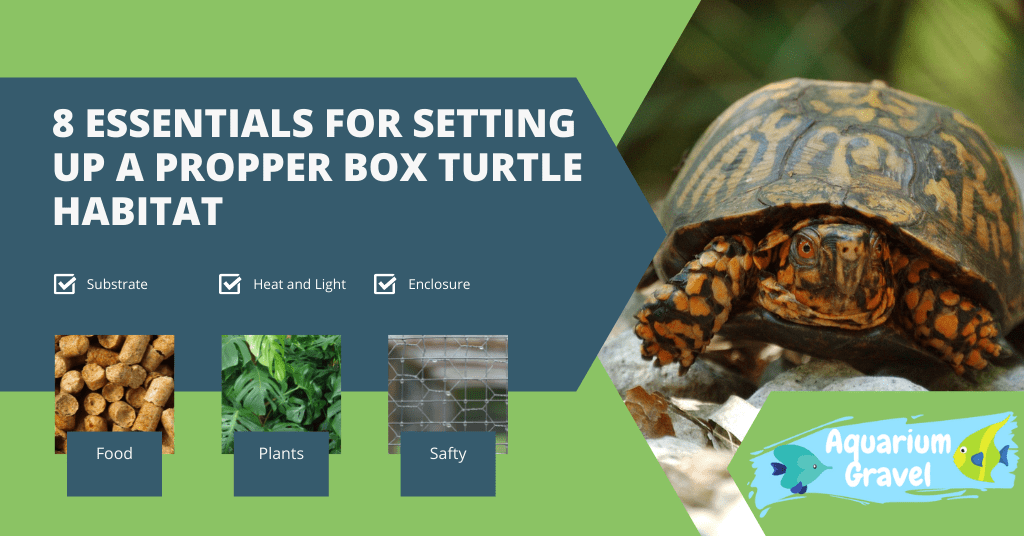Last Updated on December 2, 2021 by cmoarz
This article will focus on eastern box turtles, and not the western ornate box turtle or the desert box turtle. Check here and here respectively to see our guides on those turtles as they require a much different habitat.
The eastern box turtle has many different varieties. Three-toed box turtle, Gulf Coast box turtle, Florida box turtle, etc. This guide is ideal for this type of box turtle that likes very humid and wet environments. Western ornate box turtles and desert box turtles require significantly different habitats which are drier and sandy.
So how do you make an indoor or outdoor box turtle habitat? It already seems fairly confusing being sure you even have the right variety, so let’s just break it down in the simplest way possible.
Box turtles are in the turtle family Emydidae, with tortoises being in their own family Testudinidae. This means they’re very closely related to tortoises but still have some differences that can be noticed when you see them next to each other.
Tortoises are generally much larger than box turtles. Box turtles live in forested areas with lots of ground cover and hiding spots while tortoises prefer desert landscapes with sparse vegetation but still shelter in shaded areas during the day.
Box turtles (emydid) like water that is not too deep where they can bathe in it, or drink it without getting their face wet (so like small puddles for example), but they aren’t big swimmers either. They’re not quite as thirsty as tortoises, but do need to drink regularly so take this into consideration when making your habitat!
Good enough, Let’s get started.

How to make a box turtle habitat, 8 Essentials
Table of Contents
1. Enclosure size, indoor box turtle habitat, and outdoor habitat
For Box Turtle Habitat Indoor
First, you need to pick your container. Something you will use as a box turtle pen. Captive box turtles require at least 4×4 square feet as an adult, While hatchlings can do with much less starting out.
For indoor enclosures, A large kiddy pool or sandbox, or other plastic container or plastic tub can do in a pinch. You can also build something out of wood which is the most common box turtle pen type.
For hatchlings, a 20-gallon glass aquarium, or a large Rubbermaid container will do nicely. You will need to eventually upgrade as it gets larger, however. So be sure to have something ready as glass aquariums get more unrealistic the bigger they get.
If you are building your own enclosure rather than buying a premade one (like this one) the walls should be at least 30CM high, higher is always better.
I’ve included some photos of other people’s enclosures to give you a rough idea of what you need to create your indoor habitat.

a 4×4 can fit multiple turtles, But you shouldn’t go overboard without also increasing the size of the enclosure.
Multi-level enclosures are not recommended as the turtles can fall and hurt themselves. The exception being if the entire area is fenced off so they can’t fall and there is a ramp to go up and down with enough places on the ramp to get a good grip and to stop any rolling.
Outdoor Box Turtle Habitat
An outdoor enclosure is by far the most recommended box turtle pen. This really only works for warmer climates though, and your turtle will most likely go through a hibernation cycle.
If you live in a climate that gets too cold or too hot for your turtle, you should consider keeping them inside.
If your climate is ideal, however, setting up an outdoor enclosure can be very rewarding! Here are some photos of other people’s setups so you have an idea of what to do.
Your options are basically infinite. You just need a place that will provide shelter from rain and sun (preferably with overhanging vegetation). Your animals would prefer something shady to rest under but they will take any area that has protection from the elements. The fence height should be 30cm tall at least, again higher being better. Especially when outdoors is concerned to keep him safe from other predators.
Entirely caged in with wire mesh is definitely not going too far with concern to the safety of your turtle.
If you live anywhere besides North America where it’s winter for most of the year, you will need to bring him inside during this time or he will go into hibernation. That’s fine to allow to happen (as long as it’s not too cold), but your turtle should be in good health first, get a checkup before allowing hibernation.

2. Substrate, Enclosure bedding and Decorations
The substrate is important for matching the box turtles’ natural environment.
Maintain high humidity for Eastern Box Turtles in an indoor enclosure by providing a moist substrate and misting daily.
Sphagnum moss is an excellent choice because it maintains a high level of moisture. Turtles may also utilize sphagnum moss to dig and conceal themselves in. You can easily mix the moss with coconut husk fiber. The mix of both the coconut fiber and the moss will hold moisture very well and help keep humidity levels up. (I recommend getting a humidity gauge!)
You can even go one step further and mix in peat-based potting soil, various forms of leaf litter, etc. You can also spread leaf litter on top of the mixture to help keep it from drying out.
Some other substrate options include Orchid bark, cypress mulch, etc.
You can also add small patches of wood chips in various locations so the turtle has some variety in where he feels like sitting or standing on any particular day.
Turtles are well-known for being private by nature and wanting to hide themselves the majority of the time. Add logs, huts, and plants to their enclosure to offer them several possibilities to hide in saftly. These substrates will also make it easy for your turtle to easily burrow into.
All in all, the substrate layers should be several inches deep. Not so deep that you never find your turtle again, But deep enough he can burrow himself in a bit. Several inches should be enough.
You should also have a large flat rock for them to lay on and absorb heat from and help regulate body temperature. This is also known as a basking spot. Usually, this is placed on the warm side of the enclosure where the heat source is located, which ill get more into in the temperature section.

3. Plantlife – Plants for indoor box turtle habitat
Whether you have an indoor box turtle enclosure or outdoor turtle enclosure, it’s important your turtle has access to tons of plant life to make him feel right at home, just like his natural environment.
While it’s not always easy to match eastern united states plant life, You can get pretty close. Just be sure whatever plants you choose to use are turtle safe and can survive the appropriate temperature of your turtle enclosure.
Here is a list of plants that are turtle safe (they can safely eat them as well):
- Wildflowers and Wildflower Mixes
- Alfalfa
- Shrub Oak
- Collard greens
- Sagebrush
- Pokeweed
- Safe Herbs like parsley
- Safe Vegetables and Fruits
- Nontoxic grasses like prairie grasses
- Ferns: great shade and ground cover plants
- Clover
- Mosses: great for layering with the substrate, help retain moisture and humidity
- A variety of leaf lettuces (excluding romaine and iceberg)

4. Water
Unlike aquatic turtles, box turtles don’t really swim. But they do need water. So give them access to a shallow water dish of fresh, clean water. This dish should be large enough for the turtle to fit his entire body in and soak if he wants. You can also mist him with a spray bottle of fresh water and let it dry naturally (be sure not to make the basking area too wet). He will also drink out of this dish so be sure to change it out often. At least once a day.
Box turtles don’t like getting their face wet, so avoid deep waters. 2 to 3 inches is more than enough. If you’re dealing with smaller hatchlings, you want to go even more shallow. An inch or less!
5. Temperature
Temperature is important to the well-being of your turtles. Without warmth, they will become lethargic and disinterested in their surroundings. So for your turtle to stay healthy you need to set this up properly.
Your turtle’s enclosure should be split into 2 sides, the warm side, and the cool side.
Warm Side
The warm side should be, you guessed it, Warm. It should have a flat rock for basking under a light bulb (light bulbs that produce UVB rays (uv light)). You can buy a specially made heat lamp for your turtle on amazon or in most pet stores.
The warm side is generally a bit smaller than the cool side, which will have more space. This is mostly due to the fact that a heat lamp can only cover so much area, and they really don’t need that area to be very big.
You want to make sure your turtle stays warm enough at all times! So in addition to a basking light and the ambient room temperature (which we will talk about in a bit), You can place a heat mat on this side of your enclosure’s floor. This will help keep him warmer when he’s not under his basking light.
Cool Side
The cooler side should be just that, cooler. And I don’t mean where all the cool turtles hang out, Just colder! Someplace the turtle can help regulate its cold-blooded body temperature.
This is where you should have the most plants and shade possible, as well as where you generally want to situate your water dish.
- Basking: 85–90 F
- Air temperature: 75–85 F
- Humidity: 70–80%
You want to maintain the same humidity on both sides of the enclosure. Outdoor enclosures are a bit harder to deal with when it comes to humidity, so be sure to add enough water areas to make up for it so your turtle doesn’t dry out!

6. Lighting
Aside from your heat lamp, You will need general lighting. Incandescent 40 – 60 watt light bulbs are ideal for this. This type of lightbulb is relatively cheap and easy to replace. For an outdoor enclosure, aside from a heat lamp, a light bulb won’t be necessary here as the sun will do what the sun does best. The best UVB rays come from the sun after all.
7. What to feed your eastern box turtle
Your turtle will need a well-rounded diet of
- 60% protein
- 40% plant
You can supplement their diet with commercial pellets (soaked in water first, never dry), but you should also give them a variety of fresh foods as well.
Combine pelleted food with veggies and fruit to give your turtle a complete diet.
Feeder insects include:
- Roaches
- Hornworms
- Crickets
- Earthworms
- Phoenix worms
- Nightcrawlers
- Other insects and Creepy crawly feeder species
Insects can be obtained in a variety of ways. The majority are available at pet shops or online. Bugs from your backyard shouldn’t be fed because they may have been exposed to pesticides and make your turtle ill.
Leafy greens, such as:
- Endive
- Escarole
- Dandelion leaves
- Romaine lettuce
- Plantain weed
For Eastern Box Turtles, these are excellent vegetables:
- Sweet potato
- Prickly pear cactus pads without their spines
- Pumpkin
- Carrot
- Any squash variety
- Zucchini
All of these fruits make wonderful snacks for Eastern Box Turtles:
- Blueberries
- Papayas
- Prickly pear fruits
- Strawberries
- Bananas
- Blackberries
- Cantaloupes
- Apples
8. Enclosure maintenance
Maintenance is always an important factor to any pet, turtle included. Here is a general maintenance list:
- Clean out poop daily
- Change substrate once every 6 months (Be sure to add cleanup crew like isopods and springtails to help keep things clean)
- Refresh water daily.
- Trim plants, water plants, and give nutrients to plants when needed. You can use your leftover turtle poop if you want!
- Bring your turtle for regular checkups at a reptile vet. Follow any veterinary advice they give.
These are of course only general guidelines! Good luck!
About
Owner of AquariumGravel.com and also owner of actual Aquarium Gravel believe it or not! ;). Setting up beautiful aquarium sceneries and habitats since I was very young. Enjoy!
- Web |
- More Posts(290)

